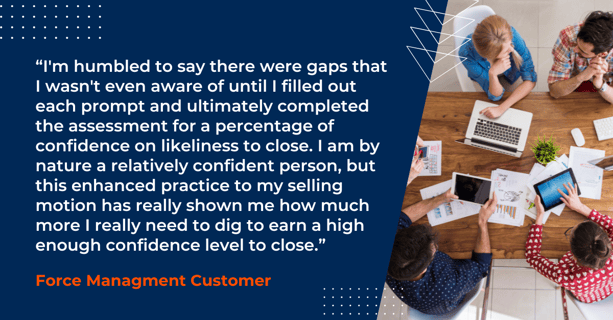
3 Forecasting Habits of High-Performing Sales Organizations
Categories: Sales Planning | Sales Qualification | Scaling Sales
Achieving 100% forecast accuracy is a goal for any sales organization, but at times it can feel out of our hands. So many factors affect a successful forecast: external economic factors, problems within the buyer organization and the ability of sales teams to predict and execute their number. How do you improve forecast accuracy as a sales leader?
The most elite sales organizations maintain forecast accuracy, even during times of economic flux. They do so by practicing sales agility. At Force Management, we define sales agility as the ability to pivot the sales strategy in real time with changing buyer priorities and problems. Sales teams who practice an agile forecasting process do the following three things consistently.
1. They Operate On A Custom Qualification Framework
The most important forecasting tool of an agile sales force is a consistent qualification system. Customization of your qualification criteria to a clearly defined value message is key to creating a high efficiency and repeatable operating rhythm.
We describe qualification systems like MEDDICC as an X-ray, where the value message is the treatment. As the qualification process identifies the unanswered questions of the deal, the messaging framework enables reps to answer them. This ability can be crucial to moving a deal forward at a higher value, especially in complex selling environments with multiple decision-makers. Take this firsthand account of how top-down visibility into deal status impacts the seller experience:
.png?width=667&height=349&name=customer%20quote%20templates%20(1).png)
Organizations that train this qualification muscle ensure sales time is spent in the right areas, effectively managing investment of time and resources. This not only protects their pipeline in the event of economic windfall, but opens the door to growth. Teams stop revisiting the same deal time and time again. They’re more prepared with strategies to handle potential roadblocks, freeing up time for new business and solidifying the next quarter’s forecast.
2. They Live by Customer Verifiable Outcomes
Elite sales organizations practice sales agility in forecasting by staying in sync with the customer and reading their buying signs. This means that their sales process is always aligned with the customer’s buying process, even as it changes. High buyer awareness is a cross-functional skill that involves the collaboration of all your customer-facing teams.
Sales teams stay up-to-date on individual customer issues as well as broader market trends among the customer base by listening to the customer in the process of selling, delivery and account management. They rely on customer verifiable outcomes (CVOs) to indicate their “buying state of mind." CVOs may include things like:
- Documented pain points
- Implications of the customer’s current situation
- Criteria that indicate the customer is ready to invest in resources
When sales, marketing and customer success are aligned on these key indicators and communicate efficiently around them, both the customer and your team benefit. Your team benefits with a clearer picture of the deals ahead, while customers benefit with customized value that helps them envision how your company's solution will drive their desired positive business outcomes. Especially in a complex and price-conscious selling environment, leveraging customer-sourced information to maximize value is key to removing unexpected variables in the forecast. Sales leaders can enable this skill by clearly defining customer verifiable outcomes that constitute a great deal for their organization, and creating internal communication channels that capture value throughout critical handoff points in the customer journey.
3. They Leverage Deal Management Tools
The key to unlocking forecasting accuracy is consistency and predictability, but how can you realistically achieve uniform application of a strategy across the entire sales function? Today’s leading sales organizations are leveraging tech to help reduce friction in the discovery and forecasting process. In a highly competitive market, that flexibility can make all the difference. Without it, your team could be stuck revising forecasts or chasing down deals at quarter close while competitors are busy exploiting opportunities for upsell and building new pipeline.
Modern sales organizations use various forecasting tools to map out their sales projections. Each of them relies upon inputs of deal data from managers and sales teams. The accuracy of these inputs and the method by which they are collected can vary widely. This variability is often what holds many organizations back from 100% forecast accuracy.

Integrated tools like Opportunity Manager encourage the collection of more specific and verifiable deal data, increasing visibility into the forecast and simplifying collaboration.
When everyone on the sales team is collecting the same data points and comparing them against the same standards, they now have an objective scale on which to grade their opportunities. Not only does this help your sales team get real about the forecast, but it highlights opportunities for expansion and improvement.
Start Forecasting with Confidence
Enable your team to focus their energy on pursuing larger deals and building pipeline. It starts with a methodical approach to discovery, messaging and forecasting. Align these elements and create a revenue machine that remains competitive in a changing market - this guide is a great place to get started.



